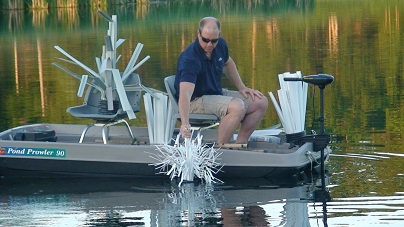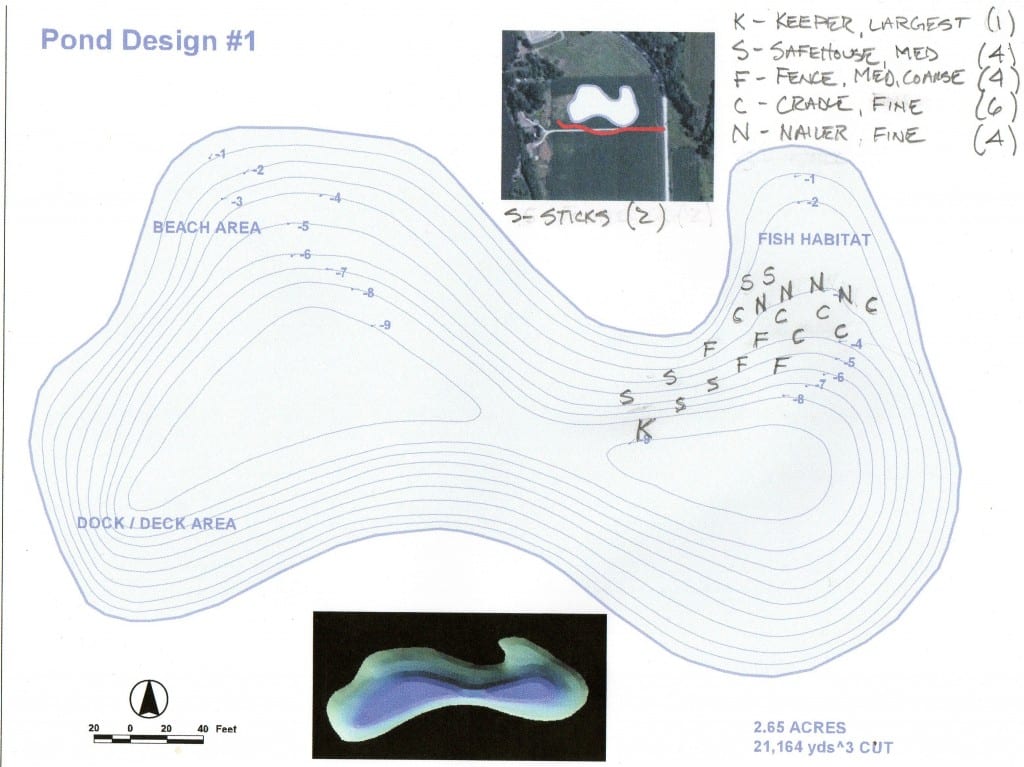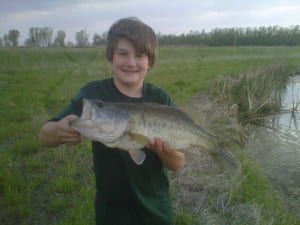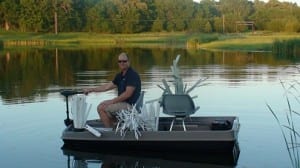
Recently, we sent an array of different fishiding products out to what may seem to be an unlikely place for fish habitat. Gretna, Nebraska, filled with flowing prairies, lush woodlands and yes, lakes and ponds. It only took a couple of e-mails to really hit off a friendship formed from a mutual love of the outdoors. We talked about fishing and hunting experiences as well as the need to promote habitat restoration for all fish and wildlife. Aaron owns a company called Premier Outdoor Properties,Inc., who specialize in large tract properties for the outdoorsman and nature lover alike. Teaming up with Cabela’s, they offer full real estate services along with knowedgable staff who love the outdoors, helping their clients achieve their individual goals. Whether it’s hunting for upland birds, or fishing for trout, these folks have what it takes to find that perfect piece of heaven.

After talking in detail about the pond and his goals, Aaron and I came up with a habitat plan that would help the fishery and continue to allow swimming and other water activities continue as always.”My biologists brings by extra bluegill fry when he gets them otherwise only feeding is by hand. The pond design pic is exactly what we built. On one end we have shallow bedding areas 2-3′ deep. We do have an aerator and are looking to add a fountain this summer om the other end. Depth is about 9 ft with 3:1 slopes. We treat for algae and weeds once a year. The bottom is clay and sealed with ESS13 (betonite type product.)”
 We sent out a group of 19 structure units ranging from shallow water cradles, to the deepest keeper units, for the deepest section of the lake. The key to installing fish habitat is placing it continuously, from shallow to deep water. When fry are hatched, it is in the shallow, warm water in the spring. These tiny little guys need tight, dense cover to hide in from predators, being mom and dad as well. Fish will eat whatever is available to them, including their own fry. After a few months growing and hiding in the shallow cover, they explore the lake out to maybe four to six feet of water. Here they continue to grow and hide amongst the provided habitat, still vulnerable to the larger predators. Over time, they grow to the preffered size to become food for the largest predators to feed on. Without this nursery and constant renewal of fish that survive, your lake or pond cannot become completely balanced, providing a healthy year class of new fish annually.
We sent out a group of 19 structure units ranging from shallow water cradles, to the deepest keeper units, for the deepest section of the lake. The key to installing fish habitat is placing it continuously, from shallow to deep water. When fry are hatched, it is in the shallow, warm water in the spring. These tiny little guys need tight, dense cover to hide in from predators, being mom and dad as well. Fish will eat whatever is available to them, including their own fry. After a few months growing and hiding in the shallow cover, they explore the lake out to maybe four to six feet of water. Here they continue to grow and hide amongst the provided habitat, still vulnerable to the larger predators. Over time, they grow to the preffered size to become food for the largest predators to feed on. Without this nursery and constant renewal of fish that survive, your lake or pond cannot become completely balanced, providing a healthy year class of new fish annually.
There are many benefits to using artificial pvc fish attractors, sometimes called fish habitat or fish cover. The most obvious would be the fact that they will last forever. For years fisherman and lake and pond management companies have been installing various natural/wood products for fish habitat. This works great, but only for a short time. Depending on the water quality, they may decompose a soon after as one year, typically in 2-4 years. Only half of that time underwater, does the structure hold it’s shape and provide usable habitat. The younger generation of biologists and fisheries professionals see the added benefits to the fish, when the habitat stays for good to be used continuously.
All the products that fishiding.com offers come with self weighted containers, with no assembly, tools or suppies needed. Just bend each limb to any shape you like and toss it in the lake. The base sinks first every time to stand the unit upright in the vertical position as it comes to rest on the lake floor. Testing has shown each unit will stand vertical on slopes up to thirty degree, with an array of lake bed material types.
 The real payoff is to see the results first hand. Getting our kids involved in the outdoors, not only from an enjoyment standpoint, but also to educate. We as adults have the obligation to educate the youth of America regarding the need to restore, save and conserve the great outdoors God has given to us all to enjoy and protect. Some of that starts with recycling.
The real payoff is to see the results first hand. Getting our kids involved in the outdoors, not only from an enjoyment standpoint, but also to educate. We as adults have the obligation to educate the youth of America regarding the need to restore, save and conserve the great outdoors God has given to us all to enjoy and protect. Some of that starts with recycling.
Fishiding is currently the only producer of fish habitat products of any kind, made entirely from reclaimed pvc products. Much effort has been put into gaining a network of suppliers to provide material to be used for habitat in lieu of getting dumped in a landfill. The concept seems simple enough, Allowing this new patented process and concept to explode into over 40 states and counting.
During this off season, take some time to look over the website and see all the different products, sizes and textures of artificial fish habitat attractors available for every application. Aaron promised to keep us up to date with his pond and the habitat we installed. Go Green! and help reclaim lost or degraded fish habitat today, with the most cost effective, environmentally friendly fish attractors available. Fishiding.com
See the dozens of unique artificial fish habitat models, fish attractors and fish cover used at fishiding.com, the industry leader and only science based, man made and artificial fish habitat, proven to provide all fish with cover they prefer to prosper.


 CHRONICLE FILE PHOTO The flooded Muskegon River put the majority of Terry Bayne’s 52-acre Cedar Creek Township farm under water in April. â??The problem is, there’s no place for it to go,â? Bayne said about the water.
CHRONICLE FILE PHOTO The flooded Muskegon River put the majority of Terry Bayne’s 52-acre Cedar Creek Township farm under water in April. â??The problem is, there’s no place for it to go,â? Bayne said about the water.



